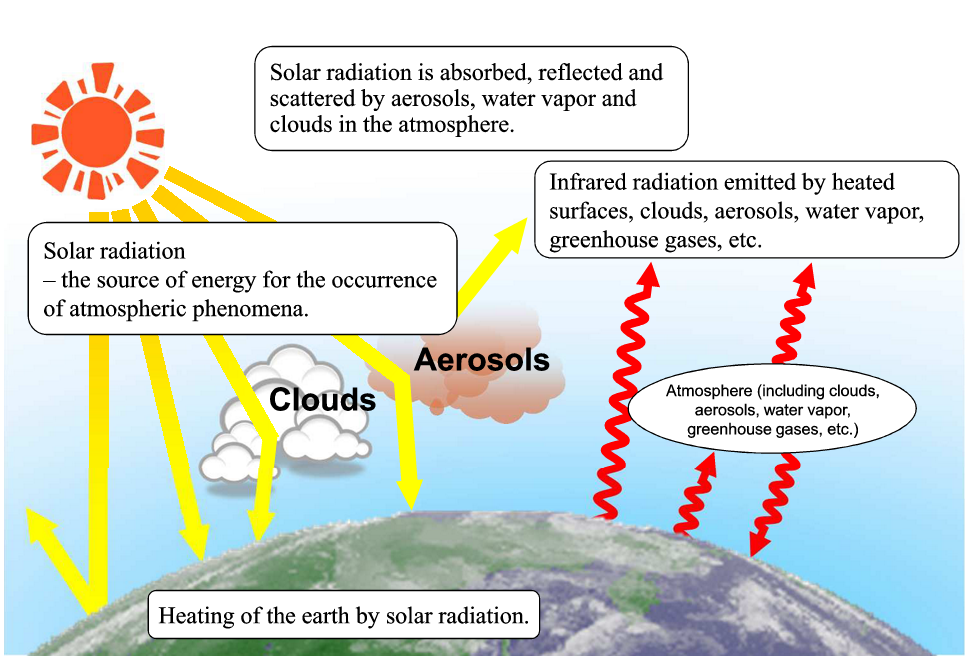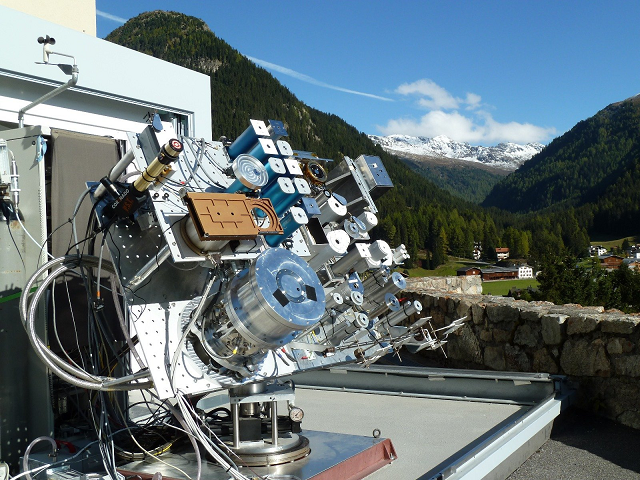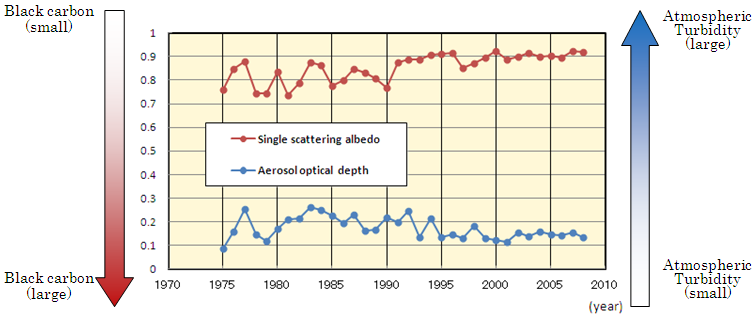Solar radiation emitted from the sun provides energy for the occurrence of atmospheric phenomena. Some such radiation is reflected back into space by clouds and aerosols in the atmosphere and by bright parts of the earth's surface such as areas of snow or ice and deserts.
All other solar radiation is absorbed by the atmosphere and the earth's surface (land, sea, lakes, etc.), resulting in a heating effect. In turn, these heated elements (including clouds, aerosols, water vapor and greenhouse gases) emit infrared radiation depending on their temperature.
Carbon dioxide, methane and other gases in the earth's atmosphere allow most incoming solar radiation to pass, but absorb infrared radiation heading from the earth's surface into space (upward infrared radiation) and re-emit it in all directions.
As some of this reflected radiation is sent back toward the ground surface (known as downward infrared radiation), the temperature of the atmosphere and land surface is higher than it would be if these gases were not present.
This mechanism is called the greenhouse effect, and the gases that cause it are called greenhouse gases. Infrared radiation increases with greater concentrations of atmospheric greenhouse gases, while the amount of solar radiation reaching the earth's surface depends mainly on atmospheric amounts of water vapor and clouds, ozone and aerosols.
By way of example, the 1991 eruption of Mt. Pinatubo in the Philippines sent masses of SO2 into the stratosphere and caused a significant increase in stratospheric aerosol concentration. The resulting increase in turbidity reduced the amount of solar radiation reaching the earth's surface, and the global mean temperature fell for about two years after the eruption.
Thus, changes in infrared and solar radiation are a factor behind long-term climate change, although their impact on the climate is not fully understood due to the enormous number of processes involved and the complex relationships that link them.
Against such a background, precise observation of infrared and solar radiation is required in order to monitor, predict and elucidate the mechanism behind climate change.

Relationship between Solar and Infrared Radiation
The BSRN was established under the World Climate Research Programme (WCRP) to support precise measurement of solar and infrared radiation at the surface for the data needed to reduce the uncertainty of climate change prediction and clarification.
In 2004, the network was designated as a surface radiation global baseline network for the Global Climate Observing System (GCOS).
All over the world, there are about 60 active observation stations. Data collected at BSRN stations is provided free of charge by the World Radiation Monitoring Center (Germany's Alfred Wegener Institute (AWI) for Polar and Marine Research).
The BSRN also supports the development of new technology in radiation measurement and plays a leading role in the advancement of radiation measurement technology as part of the WMO Commission for Instruments and Methods of Observation (CIMO).
Japan Meteorological Agency operates four BSRN stations in Japan (Abashiri, Tsukuba (Tateno), Ishigakijima and Minamitorishima) and one in Antarctica (Syowa Station).

BSRN stations (As of July 2024)
(from World Radiation Monitoring Center website)
Direct solar radiation measurements express the amount of solar radiation received by a plane perpendicular to the vector of an incident solar beam. When JMA commenced observation of direct solar radiation in 1932, silver-disk pyrheliometers were used. Although these had outstanding precision and stability and the data collected using them were highly reliable, the manual work involved in their operation and the lack of capacity for continuous observation were significant disadvantages. As a result, these units were gradually replaced from 1978 onward by electric pyrheliometers on equatorial mountings to allow continuous observation of direct solar radiation. Completely automated observation began in 1992 with pyrheliometers mounted on automated sun trackers. The figure below shows a view of the current observation system.

Precision observation system for solar and infrared radiation
From among the various atmospheric turbidity coefficient definitions available, JMA performs calculation according to that of Feussner and Dubois. The coefficient is calculated from instantaneous solar radiation (irradiance) measured during the 30-minute periods before and after 9:00, 12:00 and 15:00 in local apparent solar times with no clouds between the observing system and the sun.
Direct solar irradiance per unit wavelength at a wavelength of  decreases exponentially with greater optical air mass and optical depth. The amount of direct solar irradiance
decreases exponentially with greater optical air mass and optical depth. The amount of direct solar irradiance  reaching the ground at wavelength
reaching the ground at wavelength  per unit wavelength is expressed by the following equation based on Beer's Law:
per unit wavelength is expressed by the following equation based on Beer's Law:
 (1)
(1)
 is the intensity of extra-terrestrial solar irradiance per unit wavelength at a wavelength of
is the intensity of extra-terrestrial solar irradiance per unit wavelength at a wavelength of  ,
,
 is the atmospheric optical depth when the optical air mass is 1, or the attenuation coefficient of direct solar irradiance for a vertical column, and
is the atmospheric optical depth when the optical air mass is 1, or the attenuation coefficient of direct solar irradiance for a vertical column, and  is the optical air mass representing the depth of the atmospheric layer through which solar beam passes, defined as 1 on the vertical plane. Beer's Law is a theory for a single wavelength, while
is the optical air mass representing the depth of the atmospheric layer through which solar beam passes, defined as 1 on the vertical plane. Beer's Law is a theory for a single wavelength, while  and
and  are wavelength-dependent. Meanwhile, the wavelength range for JMA's observation of direct solar radiation is between about 0.3 and 3.0 µm.
However, the atmospheric turbidity coefficient is calculated using the equation shown below with the assumption that the above equation holds approximately when integrated over this range of wavelengths.
are wavelength-dependent. Meanwhile, the wavelength range for JMA's observation of direct solar radiation is between about 0.3 and 3.0 µm.
However, the atmospheric turbidity coefficient is calculated using the equation shown below with the assumption that the above equation holds approximately when integrated over this range of wavelengths.
Attenuation for direct solar irradiance is expressed using the following equation, which is obtained by integrating Equation (1) with respect to wavelength:
 (2)
(2)
 in Equation (2) is expressed by the following equation dividing solar radiation attenuation into its different components:
in Equation (2) is expressed by the following equation dividing solar radiation attenuation into its different components:
 (3)
(3)
 is the optical depth averaged over the wavelength range in relation to Rayleigh scattering in an ideal atmosphere at standard pressure with no water vapor,
O3, CO2, aerosol or other such influences when the optical air mass is 1;
is the optical depth averaged over the wavelength range in relation to Rayleigh scattering in an ideal atmosphere at standard pressure with no water vapor,
O3, CO2, aerosol or other such influences when the optical air mass is 1;  is the optical depth averaged over the wavelength range in relation to the absorption of gases (e.g., water vapor,
O3, and CO2) when the optical air mass is 1 at atmospheric pressure
is the optical depth averaged over the wavelength range in relation to the absorption of gases (e.g., water vapor,
O3, and CO2) when the optical air mass is 1 at atmospheric pressure  ;
;
 is the optical depth averaged over the wavelength range in relation to scattering and absorption by aerosols when the optical air mass is 1 at atmospheric pressure
is the optical depth averaged over the wavelength range in relation to scattering and absorption by aerosols when the optical air mass is 1 at atmospheric pressure  ;
;
 is the local pressure at the observation site at the time of observation; and
is the local pressure at the observation site at the time of observation; and
 is the standard atmospheric pressure. Substituting Equation (3) into Equation (2) gives
is the standard atmospheric pressure. Substituting Equation (3) into Equation (2) gives
 (4)
(4)
 ,
Equation (4) is expressed as
,
Equation (4) is expressed as
 (5)
(5)
 (6)
(6)
Linke's turbidity coefficient is a quantity expressing t, which is the ratio of the optical depth of the actual atmosphere containing water vapor, O3, CO2,
aerosols and other such influences to that of an ideal hypothetical atmosphere containing only air particles (known as the Rayleigh atmosphere). The value of  is needed to determine
is needed to determine ,
and is given as a function of the absolute optical air mass
,
and is given as a function of the absolute optical air mass  .
Intercomparison of observed optical depths is therefore impractical with different pressure conditions even if the values of
.
Intercomparison of observed optical depths is therefore impractical with different pressure conditions even if the values of  are the same. Against this background, Feussner-Dubois proposed correcting
are the same. Against this background, Feussner-Dubois proposed correcting  for standard atmospheric pressure. The Feussner-Dubois turbidity coefficient
for standard atmospheric pressure. The Feussner-Dubois turbidity coefficient  is expressed by the following equation:
is expressed by the following equation:
 (7)
(7)
Where
 is the optical depth averaged over the wavelength range in relation to Rayleigh scattering in an ideal atmosphere at standard atmospheric pressure with no water vapor, O3, CO2,
aerosols or other such influences when the optical air mass is
is the optical depth averaged over the wavelength range in relation to Rayleigh scattering in an ideal atmosphere at standard atmospheric pressure with no water vapor, O3, CO2,
aerosols or other such influences when the optical air mass is  .
.
Pyrheliometric scales, which form the basis of solar radiation observation, previously included the Ångström pyrheliometric scale, which was based on the Ångström pyrheliometer and used in Europe, and the Smithsonian pyrheliometric scale, which was based on water-flow and silver-disk pyrheliometers and used in the USA. However, comparisons between these two older scales revealed systematic bias caused by structural differences in the standard systems. For this reason, an integrated international pyrheliometric scale (IPS-1956) was established in 1956. In 1980, WMO adopted the World Radiometric Reference (WRR), which was maintained by a group of absolute cavity radiometers called as the World Standard Group (WSG). Japan had long used the Smithsonian pyrheliometric scale since the beginning of its solar radiation observation activities, but adopted the international pyrheliometric scale (IPS-1956) in 1957 and the World Radiometric Reference (WRR) in 1981.
To support the acquisition of globally homogenous high-precision solar radiation data through the maintenance of standards for related observation via a pyrheliometer calibration framework, the WMO World Radiation Center (WRC) was established in 1971 at the Physical Meteorological Observatory Davos (PMOD) in Switzerland, where the WSG for defining the WRR is maintained. The WRR is distributed every five years to ensure the accuracy of national and regional standards based on international comparison. As a result, the precision of solar radiation observation is maintained in a globally homogeneous manner.
JMA was appointed as the Regional Radiation Center (RRC) for WMO Regional Association-II (Asia) at the RA-II fourth session in 1965. Since 1970, the Agency has taken part in intercomparisons with the WRR held at the WRC every five years. It also works to maintain regional standards as well as conducting intercomparisons with other countries in the region as a way of helping to ensure the accuracy of solar radiation observation in RA-II.
JMA also serves as a national radiation center and is responsible for calibration of pyrheliometers and pyranometers used in Japan. To assure the accuracy of these instruments in observation by JMA, each one is tested every five years via intercomparison with the national standard and linearity checking of outputs dependent on temperature changes.

|
Group of world standards for absolute radiometers |
|
History of international pyrheliometer comparison |
| Year | Venue | |
|---|---|---|
| 1 | 1959 | Davos, Switzerland |
| 2 | 1964 | Davos, Switzerland |
| 3 | 1970 | Davos, Switzerland |
| 4 | 1975 | Davos, Switzerland |
| 5 | 1980 | Davos, Switzerland |
| 6 | 1985 | Davos, Switzerland |
| 7 | 1990 | Davos, Switzerland |
| 8 | 1995 | Davos, Switzerland |
| 9 | 2000 | Davos, Switzerland |
| 10 | 2005 | Davos, Switzerland |
| 11 | 2010 | Davos, Switzerland |
| 12 | 2015 | Davos, Switzerland |
| 13 | 2021 | Davos, Switzerland |
Since the 1960s, reduced amounts of surface solar radiation have been observed in many areas of the world. This phenomenon, known as global dimming, is seen not only in industrial areas but also in "clean" areas such as Mauna Loa, the Arctic and the Antarctic.
The reduction in the amount of surface solar radiation during the 30-year period from 1961 to 1990 is estimated to have been 4% (7 W/m2) (Liepert, 2002*1). This is thought to stem from increased aerosol concentrations and aerosol optical depths (AODs) due to greater emissions of human-induced aerosols and aerosol precursors.
In spite of the reduction, the land surface temperature increased by about 0.4 K from 1961 to 1990 (Jones et al., 1999*2). Wild et al. (2004)*3 suggested that this temperature rise may be a result of reduced evaporation (i.e., lower loss of latent heat) judging from the energy balance of the earth's surface, as the phenomenon cannot be explained by greater concentrations of greenhouse gases.
Roeckner et al. (1999)*4 and Liepert et al. (2004)*5 also reported that the reduction of surface solar radiation resulting from increased AODs due to human-induced aerosol emissions has a much more significant influence on the earth's surface energy balance than surface temperature rises caused by greenhouse gases.
These observations highlight the potential impact of reduced surface solar radiation on the water cycle, including precipitation, as a result of changes in latent heat flux.
Meanwhile, solar radiation observations conducted primarily in the Northern Hemisphere after 1990 indicate that global dimming was not observed in the 1990s, and that increasing in solar radiation has been seen over a wide area since the late 1980s (Wild et al., 2005*6; Ohmura, 2009*7). This is called global brightening as opposed to global dimming.
The monitoring of black carbon aerosols, which are emitted from biofuels such as coal, diesel and firewood, has become important in recent years. Since 2010, JMA has conducted observation of diffuse solar radiation in addition to its previous monitoring of direct solar radiation. The optical properties of airborne aerosols (known as single-scattering albedo) can be analyzed from observation data collected at the Aerological Observatory in Tsukuba and from radiation calculation using a numerical model. Aerosol single-scattering albedo, which decreases with greater concentrations of black carbon in aerosols, can be used to monitor long-term variations in atmospheric black carbon content. It is considered that the recent decrease in black carbon emissions may be a result of environmental regulations (Kudo et al., 2010*8).

Trend of Long-term Variations in Black Carbon Aerosols